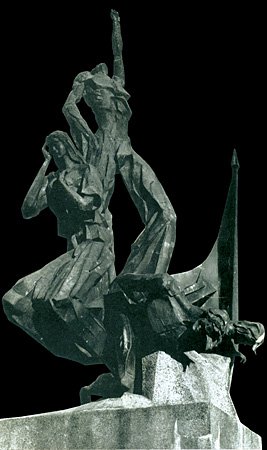Cultural Center of the Philippines
ENCYCLOPEDIA OF
PHILIPPINE ART
Pinaglabanan / Spirit of Pinaglabanan
1974 / Metal sculpture / 975 x 426 x 426 cm / Artist: Eduardo Castrillo / San Juan, Manila
Working in welded metal, Castrillo first caught public attention in the late 1960s with his looming environmental sculptures. Pinaglabanan, done to honor the site where the opening salvo was fired in the Philippine Revolution against Spain in 1896, is one of Castrillo’s large public monuments.
The raised vertical arm of the standing central figure symbolizes the unvanquished spirit of defiance and struggle against the colonial powers. This strong vertical line of the arm is repeated and reinforced by that of the flagpole. At the base of the monument are several figures in various attitudes of suffering, death, and despair, but these are transcended by the standing figure, the “Spirit,” which also unifies the group composition and represents the triumph of the anticolonial spirit despite temporary reverses. The sculptor uses expressionist distortion, lengthening the limbs to bring out the concepts more sharply. Likewise the figures are composed at angles to each other to create a dynamic contrapuntal movement.
Generally, Castrillo’s work in bronze welded together in strips, bringing out a geometrizing tendency, is characterized by jagged, angular shapes rather than by classical mellifluous forms. The jaggedness and angularity lend strength and power to Castrillo’s figures, as in this work.
Written by Alice G. Guillermo
